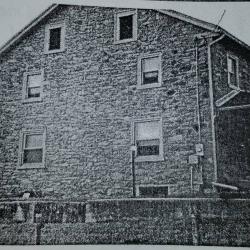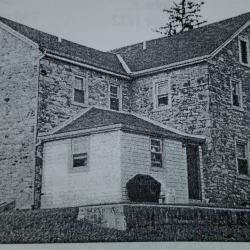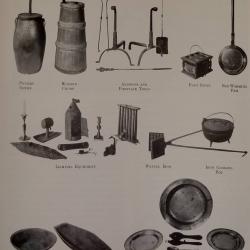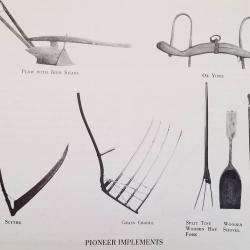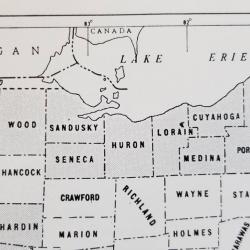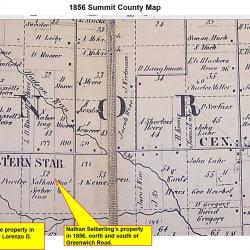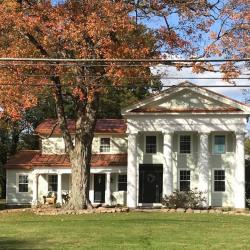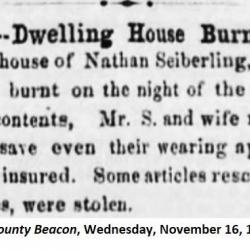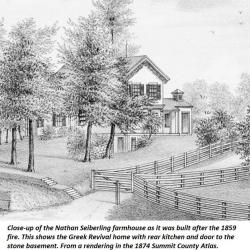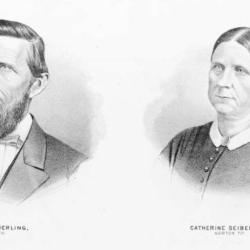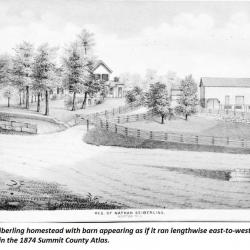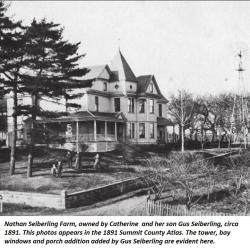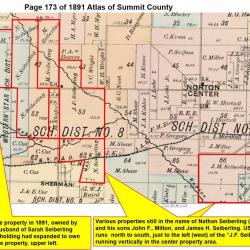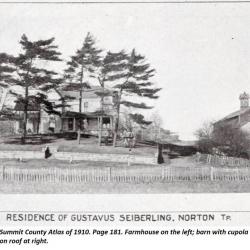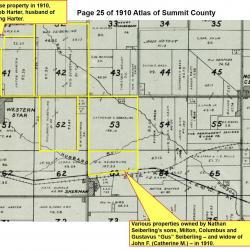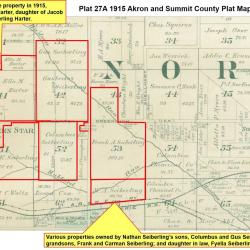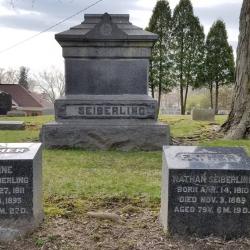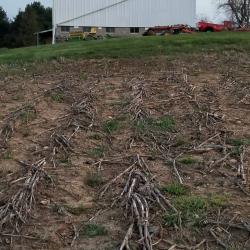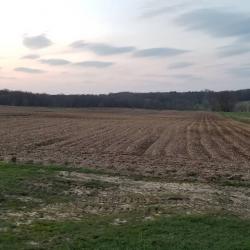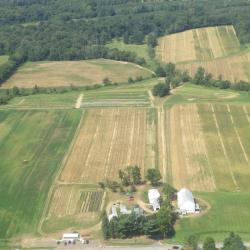News
Nathan Seiberling family history
BIOGRAPHY OF NATHAN SEIBERLING, WITH INFORMATION ON CATHERINE PETER SEIBERLING
Prepared April 2020 in Honor of His 210th Birthday and the 189th Anniversary of their Migration to Ohio from Eastern Pennsylvania for Submission to the Summit County Historical Society
Long Version
(photo gallery at the end of article)
By Harriet D. Chapman
210 YEARS AGO YESTERDAY, ON APRIL 14, 1810, NATHAN SEIBERLING was born in the German-American Lutheran community of Lynn Township, Pennsylvania, in then-Northampton County1, a few miles west of Allentown in the foothills of the Appalachian Mountains. Had he been born a day earlier, he would have celebrated the same birthday as 67-year-old Thomas Jefferson.
189 YEARS AGO TODAY, ON APRIL 15, 1831, NATHAN AND HIS YOUNG WIFE CATHERINE, and newborn daughter Kitty, began the journey westward that would bring them to a new land and a new home in the hamlet of Western Star, Norton Township, Ohio. In doing so, they joined a westward migration that had seen Ohio’s population grow 61% from 1820 to 1830 – from 581, 434 to 907,903 inhabitants in 1830. (Roseboom and Weisenburger, 1961, p. 110) In 2020, their hundreds of descendants live not only in Norton and Summit County, Ohio, but in more than half of the 50 states.
Nathan Seiberling’s life was kindly summed up in a complimentary obituary in 1889, the main points of which are here:
Mr. Seiberling was noted for his strict integrity and honesty of purpose and was never known to take undue advantage in his dealings with his fellow man. His religious character was marked. In early youth he joined the Lutheran Church, of which he remained a faithful member. In politics he was an old line Whig while that party lived. After its demise he became a Republican He was a strict temperance man and believed that his party was the only effectual body to handle that question. He was possessed with a spirit of enterprise, pluck and push rarely excelled – this was exemplified when in his 20th year, soon after his marriage, he took his young wife….toward the setting sun, to go West. To go West in those days, when railroads were unknown, meant infinitely more than it does now. After a journey attended with many difficulties they arrived in Chippewa township, Wayne Count, O….This part of the county was then a wilderness. Very little land had been cleared. Akron consisted of but a few buildings. The Ohio Canal was fast being built. Deer and other game were abundant….He was a modest, unassuming farmer and never aspired to any official honors. The only office of any note that he ever filled was justice of the peace, to which he was elected several terms. The disease that finally caused his death was chronic stomach and liver trouble of upwards of a year’s standing. His funeral will take place at 10 A.M. Wednesday, from the homestead at Western Star.” (The Summit County Beacon, Wednesday, November 6, 1889, p. 3)
But the details of his story offer insights and inspiration still today – for he and his wife overcame obstacles, loss of family, loss of home and belongings, and all the weather-related and economic and medical challenges the 19th century visited upon farmers to leave the legacies of a large, loving family; prosperous holdings; and a farm whose original purpose is being fulfilled to this day – 189 years after they settled it. THIS IS HIS STORY.
Westward Ho! From Pennsylvania to “The Ohio”
The pioneering man who would clear by hand more than 100 acres of virgin forested land in Western Star, Ohio – and become the progenitor of enterprising farmers and manufacturers who lived and worked in Summit County and beyond – began life as the third of 10 children born to Johannes “John” Frederick and Catharina Elizabeth Baer Seiberling. Born just as the Revolutionary War was ending, his parents were each 20 years old when they married in 1803; in 1807, they built the home in which Nathan was born. Thomas Jefferson was president of the United States. The sturdy stone structure, which survives to the present day, was built with the triple purpose of serving as home, hotel (two or three rooms in addition to the family’s living space) and store (front room with adjacent porch). (Byrds, 2006, p. 2) The son and grandson of farmers, Nathan’s father John was an enterprising man, who provided for his family by working as a shoemaker (a skill he passed onto Nathan), a storekeeper, a hotel-keeper and, beginning in 1820, as Lynnville’s first postmaster – a prestigious appointment that John held through 14 presidents until his death in 1875 at the age of 92. (Byrds, 2006, p. 8)
The French philosopher, writer and politician, Alexis de Tocqueville, traveled the young United States during from 1831-32 – the same period in which Nathan Seiberling moved his family west. He describes both the basic operations of mail delivery (which Nathan’s father had been supervising for a decade by this point) and the thickness of forests in the nation’s frontier, which Nathan Seiberling and pioneers like him would have encountered as they moved farther west. His description gives us insight both into the terrain and into the national communications lifeline established by an Act of Congress in 1792.
“I travelled along a portion of the frontier of the Unite States in a sort of cart which was termed The Mail. Day and night we passed with great rapidity along the roads, which were scarcely marked out, through immense forests. When the gloom of the woods became impenetrable, the coachman lighted branches of fir, and we journeyed along by the light they cast. From time to time we came to a hut in the midst of the forest, which was a post-office. The Mail dropped an enormous bundle of letters at the door of this isolated dwelling, and we pursued our way at full gallop, leaving the inhabitants of the neighboring log houses to send for their share of the treasure.” (De Tocqueville, 1835, https://www.gutenberg.org/files/815/815-h/815-h.htm)
At the time of Nathan’s birth in 1810, the United States had been operating as a constitutional republic for a mere 21 years, and its chief author, James Madison, was president. Abraham Lincoln had been born the year prior. The War of 1812 was just two years away, and the state of Ohio and the Louisiana Purchase were each only seven years old.
As a boy, Nathan worked on his grandfather Frederick Seiberling’s farm and in his father’s shoe-making shop. When time permitted, he attended German and English schools, but his formal education was neither constant nor long, and oral history says it concluded when he was 15. During that time period, “in most of the eastern [Pennsylvania] counties, German was the language of daily intercourse, of the schools, and of the newspapers.” (Shimmell, 1910, p. 150) Although official records were recorded in English, Nathan, his parents and siblings, and his wife’s family, would have spoken German to each other. While growing up, he knew his grandfather (also John Frederick – called “Frederick”) and great-grandfather, Christian, both of whom were German-speaking volunteers in the Pennsylvania Militia during the American Revolution. They fought for the freedoms for which Christian’s parents had left their portion of Baden in feudal Germany in 1741. (Christian’s parents, Michael and Christina Sauberlich, had emigrated to the American Colonies from the rural winemaking and farming town of Ellmendingen, Germany, in 1741. Their surname was anglicized in Philadelphia to “Seiberling.”) His family attended the Weisenberg Township Lutheran Church, a few miles from their home in Lynnville.
On December 6, 1829, Nathan, aged 19, married his third cousin, Catharina “Catherine” Peter, who was 18 at the time. (The two shared great-great-grandparents, Casper Peter and Maria Zuppinger, who married in 1722.) (Byrds, 2006, p. 65) The daughter of Northampton County natives who had both died by the time she was five years old, Catherine inherited a small fortune of $900 at the time of her marriage. The young couple began to plan a move westward to purchase land in the former Connecticut Western Reserve, a portion of Northeast Ohio territory that was inexpensive ($5 to $7 per acre), fertile, and available. (Byrds, 2006, p. 104) Although, in 1831, the list of items subject to Ohio property taxes expanded to include dwelling places, horses, cattle, and pleasure vehicles, the increased number of items to be taxed does not seem to have dissuaded Nathan from his determination to move west. Another potential concern had been reduced: the threat from Native Americans. Just 34 years prior, in 1795, the Treaty of Greenville, which followed U.S. General Anthony’ Wayne’s victory over the western confederacy of Indian tribes at the Battle of Fallen Timbers, effectively removed the majority of threats of Native Americans to vast numbers of settlers moving west to settle in “the Ohio.” (Roseboom and Weisenburger, 1961, pp. 60-62)
Catherine gave birth on February 14, 1831 to their first child, a daughter they named Catherine and called Kitty. Just two months later, on April 15, 1831, Nathan and Catherine Seiberling departed Lynnville in a covered wagon drawn by two horses and containing basic survival and homesteading supplies, utensils, tools and necessary weapons. They began their 25-day trek with the Peter Hartman family. It is likely that the Seiberlings and Hartmans traveled part of their journey in western Pennsylvania on the first federally funded road, the Cumberland Road, and along the Ohio River until reaching the state border at Columbiana County, at which point they would have turned northwestward. The group remained together until Pittsburgh, when the Hartmans were sidelined with an ill horse. Nathan and Catherine arrived in Chippewa Township in Wayne County on May 10 to sojourn with the Paul Baughman family; the Hartmans arrived three days later. (Byrds, 2006, p. 100)
Today’s traveler in the Commonwealth of Pennsylvania experiences the beauty of thick forests, meadows, towns and cities on smooth roads built on raised earth and bridges. These structural conveniences make the modern traveler forget the tough physical obstacles posed to early pioneers by deep ravines, hills, low mountains and thick forests and brush. The Seiberlings and their contemporaries traversed this territory in wooden wagons on wooden wheels with forged iron wheel rims and axels that could break and require repair along the way. The pioneer had to ration his food, find water sources from which to drink and bathe, and be able to kill, prepare and cook wildlife when salted meat and dried fruits or preserved vegetables ran low. Women caring for children were both tough and vulnerable – they had to cradle infants and take care of children’s needs (and their own health requirements) during long days of discomfort on hard seats and throughout variable weather conditions. While Native Americans were of little threat to Pennsylvania and Ohio residents and travelers in 1831, there was still plenty of risk to be faced from punishing rains, wind and temperatures, mudslides, muddy roads, errant rocks, downed tree trunks, threats to travelers’ and horses’ health, and predatory wildlife and highwaymen. No doubt, these young pioneers anticipated these challenges, and learned lessons from their predecessors on where and how to travel; nevertheless, they had to face situations with thick skins, aplomb, pragmatism and an agile inventiveness at which their descendants might wonder today.
Settling on Seiberling Farm
Within three weeks of arriving in Wayne County, Ohio, the Seiberlings had used $600 of Catherine’s inheritance to purchase 100 acres of land with a partially built cabin just north, in the Medina County hamlet of Western Star. At that time, Western Star was one of seven small villages that comprised the five square miles of Norton Township, which had been founded in 1818. It is a testament to Norton residents’ efforts to preserve some of the area’s historic character that these hamlets, now crossroads, are still known by their older names to locals: Western Star, Hametown, Johnson’s Corners, Loyal Oak (which succeeded the name Bates Corners), New Portage, Norton Center and Sherman.
By July 1831, Nathan had finished off the log cabin that would be home for his family until 1840, at which time he built a larger frame home. A passage which sounds as if it describes the Seiberlings, Hartmans, Baughmans and their neighbors comes from A Short History of Pennsylvania:
“In [agriculture] the Pennsylvania Germans excelled, and they therefore clung to the soil and to rural life. They were good judges of land; they worked hard, and practice economy. They cleared the land that had the heaviest timber, for they knew it would produce the heaviest crops; and the often grew rich where others had become poor. Their farms were not surpassed anywhere in the world. Through their industry and economy they have produced a large share of the wealth of the state.” (Shimmell, 1910, p. 40)
He would also have dug a well soon after arriving, to ensure a source of water closer to the home than the creek. The pump from an old well, perhaps the original, remains on the property. During their nine years in the cabin, six more children would be born, with another eight to be born in the larger home. Coincidentally in 1840, Summit County, Ohio, was carved from Medina and Portage Counties, and Norton Township – and thus, the Seiberlings’ home and lands – transferred from Medina to Summit County.
Nathan chose to purchase land with a life-giving creek that crossed it from the northwest to the southeast. Hudson’s Run (now known by Hudson Run) is a creek that lies at the base of a small, broad valley, such that Nathan’s property then and now is one of rolling hills still replete with sandstone, quartz and other rocks embedded in the soil and worn smooth by oceans during prior millennia. These hard obstacles bear the marks of plows from many generations of earth-turning and planting, and the current farmers continue to remove rocks and boulders to line creekbeds or fill in eroded tracks in the farm’s roadways. A few arrowheads of flint found over the decades indicate that the land near the creek was a habitat for native peoples over thousands of years. According to Samuel Lane’s Fifty Years and Over of Akron and Summit County, 96 acres of Nathan’s initial purchase was uncultivated, which required him to spend his days clearing the farm of old-growth trees and brush before he could plow and plant it. Imagine the labor involved in cutting down and chopping up very tall trees with merely blows of the ax and handsaws, and with perhaps only occasional help from one’s new neighbors, given that they had their own soil to till and care for. The trees on Nathan’s land included elm, oak, maple, walnut, hickory, cherry, beech, ash, sycamore, and the occasional pine.
Here is what he might have done during his first months in Western Star:
“A newcomer, arriving upon the scene of his future labors, would grub out the small trees by the roots, cut down those less than a foot in diameter and burn them on the spot, and girdle the largest ones by chopping around them with an axe, cutting through the bark and sapwood and leaving them to stand until they fell over at the end of fifteen to twenty years. A house was generally built of logs and timbers secured from trees felled with the assistance of accommodating neighbors. The best of the houses had windows and doors, a shingled roof, a brick chimney and well-laid floors. In time these early dwellings were replaced by more substantial houses…” (Roseboom and Weisenburger, 1961, p. 119)
(For another representative glimpse into what life in Nathan’s log cabin, and the early clearing of his land, might have been like, see page 1050 in Vol. IV of Alexis de Tocqueville’s Democracy in America: Historical-Critical Edition.)2
In addition to relying early on the carefully saved and sparsely spent remainder of Catherine’s inheritance, Nathan showed himself to be the enterprising son of an enterprising father by providing for his growing family using multiple skills. He was a cobbler by night and milled as well as planted and harvested. Lebbins Hoskinson had opened a tannery in Western Star in 1830, which meant that Nathan would not have had to travel far to obtain prepared leather to make and repair shoes. (Merrick, 2015, p. 7) By 1843, he had dug out a millrace and built a sawmill to cut wood that he would use for his own barn and sell to others for their homesteads – all while steadily, persistently clearing his land to farm it and to use for animals to graze.
“Money was scarce…and cash was seldom paid. In the country, trade was on a grain basis, a day’s work being paid for with a bushel of wheat, a bushel and a half of corn, or three bushels of oats. Shoemakers, tailors, and others took their pay in grain, the customers always procuring the leather, cloth or iron, and the mechanic doing the work. Some articles at the stores, such as tea, coffee, powder, leather, and iron, could be secured only for cash, or for linen cloth, feathers, beeswax, or furs, which were not too heavy to transport and which were accepted by wholesale dealers in payment for goods. Grain was ground into meal at one of the many water mills erected on the bans of Ohio’s streams.” (Roseboom and Weisenburger, 1961, p. 119)
The beams in the current barn, which was built around 1850, are from trees that were likely planted during the late 1700s – when many of the nation’s Founders still walked the earth, and when the last Native Americans from the Iroquois and affiliated tribes were present in this area. When their exteriors are maintained, the strength of those early barns and homes is evident, such that they do not deteriorate. While the 1807 Pennsylvania home that Nathan grew up in was made of stone, only the foundations and basements of his first (1840) and second (1860) frame homes – as well as his barn – were lined with thick, quarried sandstone. Most farmhouses in this part of Ohio, at the time, were made of wood, with whitewashed, eventually plastered interior walls and wood trim.
Like most barns of the era, Nathan’s barn served multiple purposes. Built on a hill, so that entry was available on two levels, the lower level of the barn (encompassed by stone walls) was used for keeping livestock. The upper level stored faming equipment, wagons and buggies, and hay, and held two granaries. There was also a corn crib on the property and chicken coops. A cupola originally on top of the barn, and visible in an 1890s photo, was removed at one point, and there are clear indications from older renderings that the barn’s roof was raised at some point, by Nathan or Gus, to accommodate more storage. An interesting note about the barn is that the 1874 rendering shows it running lengthwise east to west, when in reality the barn runs lengthwise north to south. Nathan’s descendants and history buffs have argued over that point – whether the barn was lifted and shifted at some point after 1874, but the consensus of belief, given the foundation, is that the artist may have taken some liberties with his image when he drew it for the atlas, so it may not be entirely accurate. The well and a windmill were close by the main house. A fairly steep driveway is still a hallmark of the farm, even though Greenwich Road has likely been raised a foot or two since the property was settled. A stone wall fronting the home, which Nathan built, is slowly sinking into the earth due to erosion and land movement. As they do today, pine trees have sheltered the main house from wind and direct sun at least since 1865; we know this due to the mature pine trees visible in the 1874 rendering of the farmhouse and barn.
By 1856, Nathan had purchased an additional 85 acres of timberland immediately south of his initial stake – in what is now the Knollbrook development – and also a square plot of roughly the same acreage east of South Hametown Road where the current Dorothy Avenue and Sherman Drive are (northwest of Johnson’s Corners) in Norton. Circa 1857, he purchased the 150-acre farm, with its 1840s Greek-Revival Pillar House, from the heirs of farmer Lorenzo D. Russell. After that, he purchased other tracts that eventually increased his Norton-based holdings to 500 acres. He would also purchase land in Iowa that amounted to 1000 acres. Over time, he would sell or bequeath acreage from his various holdings to his various sons and daughters, and he had prospered enough from – and saved constantly and frugally thanks to -- his multiple occupations as cobbler, farmer, miller and carpenter that he was able to leave each of his surviving children a handsome sum of several thousand dollars each once they married.
His initial tract of land – the entity known today as Seiberling Farm, which has been continuously farmed for 189 years – was bequeathed to his youngest son Gus, to Gus’s second son Cloyd, to Cloyd’s only son Ellis, and to Nathan’s great-great-grandchildren Charles E. Seiberling and Dorothy Seiberling Dunham. The farm has grown wheat, hay, field corn, sweet corn and various vegetables over many years, and Ellis ran it as a dairy farm with milking cows. Current plantings, which are harvested beginning in mid-July, include multiple varieties of sweet corn, as well as onions, cabbage, multiple pepper varieties, tomatoes, cucumbers, zucchini, yellow squash, eggplant, green beans, broccoli, melons, berries and flowers.
Faith and Family: The Seiberling Family Patriarch
By June 1854, and from the ages of 19 to 43, Catherine had borne Nathan 15 children, whose names and years of life are identified below. While Catherine’s life can fill another post, it should be noted that childbirth or its aftereffects were not-infrequent causes of death for women, and Catherine risked this 15 separate times! She was a hardy lady who was pregnant for more than 11 years, or 13 percent of her life on earth. She beat many odds by surviving childbirth so many times, and by not succumbing to any number of other maladies or diseases that felled women (and men) younger than she. In fact, she and Nathan outlived SIX of their own children! For both Nathan and Catherine Seiberling, there are positive outcomes seemingly generated by genetic backgrounds that gave them sturdy bodies; their own hard work and self-discipline, which occupied their minds and bodies in healthy ways well into old age; and their strong Christian faith, economy and generosity.
Both were known to their family and friends as diligent and faithful Lutherans, who raised their children in the Lutheran Church and contributed to their local congregations with both money and time. A passage from Pioneer Women of the Western Reserve pays homage to the couple: “They were more than sixty year members of the Lutheran Church. It is gratifying to know that amid all their trials and hardships there was always an unstinted hospitality in the intercourse of neighbor with neighbor.”
Another observation by de Tocqueville, contemporary to Nathan’s and Catherine’s move west, shows how they and their neighbors likely devoted their time on Sundays:
“In the United States, when the seventh day of each week arrives, commercial and industrial life seems suspended; all noise ceases. A profound rest, or rather a kind of solemn recollection follows; the soul, finally, regains self-possession and contemplates itself.
During this day, the places consecrated to commerce and industry are deserted; each citizen, surrounded by his children, goes to church; there strange discourses are held forth that do not seem much made for his ears. He hears about the innumerable evils caused by pride and covetousness. He is told about the necessity to control his desires, about the fine enjoyments attached to virtue alone, and about the true happiness that accompanies it.
Back at home, you do not see him run to his business ledgers. He opens the book of the Holy Scriptures; there he finds sublime or touching portrayals of the grandeur and the goodness of the Creator, of the infinite magnificence of the works of God, of the elevated destiny reserved for men, of their duties and their rights to immortality.
This is how, from time to time, the American escapes in a way from himself, and how, tearing himself away for a moment from the petty passions that agitate his life and from the transitory interests that fill it, he enters suddenly into an ideal world where everything is great, pure, eternal.” (De Tocqueville, 1840, Vol. III, Chapter 15, https://oll.libertyfund.org/titles/tocqueville-democracy-in-america-historical-critical-edition-vol-3)
They also raised their children to succeed in parenting and farming, to have strong faiths and commitment to their churches, to engage in civic affairs, and to be self-confident enough to try their hands in other things, such as invention and manufacturing. Every one of their children would have learned the basics of weather, plowing, planting, irrigating, clearing, pest control (where possible), harvesting, preserving food, budgeting for household food consumption and clothing needs, raising and managing livestock, and the myriad other skills necessary to maintain a farm home. The women would have learned all necessary housekeeping tasks, including washing, spinning, cleaning, knitting, sewing, candle making, and cooking, and budgeting therefor. They might also have milked the cows, tended the fowl, and maintained the vegetable garden. (Roseboom and Weisenburger, 1961, p. 122) Every child of Nathan and Catherine became involved in some way in the civic and religious lives and needs of their communities. Nathan and Catherine demonstrated these obligations themselves by their commitments to their church, the grange and Summit County Agricultural Society, through political affiliations, civil obligations and through participation on school boards or oversight of their children’s schooling at the Western Star Academy.
Nathan and Catherine Seiberling’s descendants number in the hundreds. They had 82 grandchildren and 194 great-grandchildren. Both parents outlived the average lifespans of their children: he was 79 when he died, and she was just under 84, and they both buried six children prior to their own deaths. Their children who lived to adulthood averaged lifespans of 64.7 years. The daughters did not fare as well as the sons, however: of four daughters, only one lived past 50 (to age 99). Of the eight sons who lived to age 20, seven lived to age 69 or older (their average lifespan was 70.4 years). Their children are as follows:
- Catherine “Kitty,” their only Pennsylvania-born child, married and died two weeks after giving birth to her first and only child, a daughter named for her, in September 1854. 4 grandchildren. She was 23 years older than her youngest sibling, whom she knew for just three short months.
- William – their first child born in Ohio in 1832; he died in infancy.
- John Frederick, called John or J.F. in business -- 1834-1903. He was 20 years old when his youngest brother was born. A farmer and later inventor and manufacturer of farming equipment, and owner of a light railway and milling company in Akron, J.F. Seiberling and his wife Catherine Lucinda Miller (sister of Monroe’s wife Sarah) would have 11 children, nine living to adulthood, and 30 grandchildren. Their children include the founders of Goodyear Tire & Rubber Company and Seiberling Rubber Company, and seven daughters who married men who were also engaged in manufacturing or mining. He was the first Seiberling to live in Lorenzo Russell’s “Pillar House,” from roughly 1858-1860, where two of his children, Anna and Frank, were born. (Oral histories say that Charlie was born in the Pillar House in January 1861, but a passport where he had to declare his town of birth states Doylestown.)
- James Henry, called James – 1835-1916. He went into the farming equipment business with his brother, John, and married Elizabeth Baughman. They lived in Doylestown for 30 years and eventually owned land in Stark County, and later moved to Jonesboro, Indiana. They had six children and eight grandchildren.
- Sarah Ann – 1837-1937. She would live for nearly a century and four wars, dying shy of her 100th birthday and living all of her life in the “Pillar House” adjacent to her parents’ property. She married Jacob Harter and bore him seven children; they would have 19 grandchildren.
- Monroe – 1839-1908. He and his wife, Sarah Miller (sister of John’s wife Catherine), had eight children and seven grandchildren. Monroe would also do business with his brothers John and James, living first in Akron and eventually strike out for Kokomo, Indiana, building a Queen Anne-styled home there with a fortune made first in a strawboard manufacturing and then following the founding of the Diamond Plate Glass Company. After starting a tin plate company in Elwood, IN, he moved later to Illinois and established a rubber company, and another plate glass company. The first attorney he hired was William McKinley, who later spoke at the Elwood plant.
- Benjamin Franklin – 1840-1857. He died as a teenager and is buried in the northern Wayne County / Doylestown cemetery of the current Emanuel United Church of Christ.
- Mary – 1842-1881. She married Jonathan Biery of Norton and later Joseph Kemmerer. She is also buried in the Emanuel UCC cemetery. Her son Charles’ 1912 home is the current headquarters of the Norton Historical Society. Mary had five children by Jonathan and three children by Joseph and eventually had 19 grandchildren.
- Eliza Ann – 1843-1885. She married Sherman Baughman; they had eight children and 11 grandchildren. She is buried in Taylorville, Illinois.
- Frank – 1844-1844.
- Charles – 1845-1935. At 19, he enlisted in the Ohio Infantry Volunteers and served in the 103rd Regiment’s Company F from 1862-65. He was engaged in several battles in Tennessee. In 1866, he married Jerusha Betz and in 1867 moved to Mitchellville, Iowa, where he farmed and they had 13 children and 51 grandchildren.
- Nathan Septimus – 1846-1873. Known as “Sep,” he served with the Ohio Infantry Volunteers’ 198th Regiment, Company D from March-May 1865, and he returned home to marry the daughter (Joseva Ann) of his father’s neighbor Alpheus Myers in 1868. They moved to Iowa, where he is buried in Des Moines. He was the father of two sons, Allen and the future attorney, Republican congressman and Goodyear trustee, Francis Seiberling – both of whom returned to the Norton and Wadsworth area with their mother after his death. A daughter Elsie apparently died young. They had three grandchildren.
- Columbus – 1848-1917. Columbus bought land across from his father’s homestead and married Sarah Jane Miller in 1871. She was the daughter of Stephen and Mary Musser Miller and the niece of his sisters-in-law, Catherine L. and Sarah L. Miller Seiberling. They had 10 children, seven of whom lived to adulthood, and 23 grandchildren. Columbus farmed but lost his lower left arm in a corn shredder accident, after which he rented out his farm and worked for John’s strawboard factory for a few years, before adapting enough so he could return to farming. Several of his descendants help out at Seiberling Farm in the present day.
- Milton – 1850-1924. Milton married Fayetta Johnson, and lived in and farmed a small plot of five acres near his father’s at the southwest corner of Hametown and Greenwich Roads, as well a 111-acre plot on Hametown Road near Sherman. They had three daughters and 11 grandchildren.
- Gustavus Adolphus “Gus” – 1854-1938. The youngest child, Gus married Julia Culp in 1875 and remained on his parents’ original homestead. They had four children and eight grandchildren. Gus left the farm to his son, Cloyd, while his first son Wilson farmed land next door to the east. Gus served 14 years as mayor of Western Star’s village and several years as a Summit County Commissioner. Like his father and brothers, he was a Republican. He also founded the Norton Mutual Fire Association, an insurance company in Barberton that his descendants run today, and served in leadership positions as clerk and school board member for Western Star Academy.
This table summarizes the above without career details.
|
DATA POINTS ON THE CHILDREN AND DESCENDANTS OF NATHAN AND CATHERINE P. SEIBERLING
|
||||
|
Child’s Name |
Life Span, Age at Death |
Spouse |
# Children |
# Grand-children |
|
Catherine Ann “Kitty” * |
1831-1854, 23 |
Paul Wall |
1 |
4 |
|
William * |
1832-1832, 0 |
|
0 |
0 |
|
John Frederick “John” ~ |
1834-1903, 69 |
Catherine Lucinda Miller ~ |
11 |
30 |
|
James Henry |
1835-1916, 81 |
Elizabeth Baughman |
6 |
8 |
|
Sarah Ann |
1837-1937, 99 |
Jacob Harter |
7 |
19 |
|
Monroe ~ |
1839-1908, 69 |
Sarah L. Miller ~ |
8 |
7 |
|
Benjamin Franklin * |
1841-1857, 16 |
|
0 |
0 |
|
Mary ^ |
1842-1891, 49 |
Jonathan Biery Joseph Kemmerer |
5 3 |
6 13 |
|
Eliza Ann * |
1843-1885, 42 |
Sherman E. Baughman |
8 |
11 |
|
Frank * |
1844-1844, 0 |
|
0 |
0 |
|
Charles |
1845-1935, 90 |
Jerusha Betz |
13 |
51 |
|
Nathan Septimus “Sep” * |
1846-1873, 27 |
Joseva Myers |
3 |
3 |
|
Columbus “Columb” ~ |
1848-1917, 69 |
Sarah Jane Miller ~ Dora McDowell |
10 |
23 |
|
Milton |
1850-1924, 74 |
Fayetta Johnson |
3 |
11 |
|
Gustavus Adolphus “Gus” |
1854-1938, 84 |
Julia Culp |
4 |
8 |
|
TOTALS: |
|
|
82 |
194 |
|
*Died before deaths of parents Nathan (1889) and Catherine (1895). ^Outlived Nathan only. ~ Brothers John and Monroe Seiberling married sisters Catherine and Sarah Miller, daughters of John and Susan Bauer Miller, who had emigrated to Norton from Northampton Township, Pennsylvania, in 1848. Sarah Jane Miller, a niece of Catherine and Sarah L. and granddaughter of John and Susan Miller, became sister-in-law to her aunts when she married Columbus Seiberling. |
||||
Economic depressions are not new, as an article about a family gathering in the fall of 1873 points out. The Coinage Act of 1873 had been signed into law in February of that year, effectively ending the U.S. backing its currency with both gold and silver, and adopting a de facto gold standard. One of the effects was to depress the price of silver, which harmed those who held silver bullion or mined it. Other moves by the government, a constricted money supply, and the failure of a large bank contributed to the “panic” mentioned in the article, which must have been on the minds of all the adults. Nathan’s substantial gift of today’s equivalent of $21,000 to each of his 10 living children is a direct indicator of the economy and wise stewardship of his resources that he and Catherine had practiced in the 42 years since they set foot on their property. Nathan’s extended family met at his homestead on Saturday, the first of November, where his living children and 51 of 60 grandchildren gathered for a “sumptuous dinner provided by the good old mother,” Catherine Seiberling. After the meal, they:
“…took a stroll over the old farm and up the old mill race and many were the old-time incidents that different objects would bring to recollection. Among them was the old beach tree on the race bank, on which they found, among others, nearly all their names, with dates, showing that they were cut there at different times, dating back to thirty years ago [1843]; and the old saw mill now fast going to decay, the birthplace of the Excelsior Reaping and Mowing Machine. The mill has stood over forty years and has been the scene of many a family and neighborhood incident. On their return to the house they were treated to a very pleasant and agreeable surprise in the shape of the presentation by the father [Nathan] of $1,000 to each of his children. The occasion was brought to a close by each one agreeing that they would be present at the next re-union, panic or no panic.” (The Summit County Beacon, November 5, 1873, page 3.)
The Seiberlings’ legacies of children, land holdings and general prosperity are not the full story. Even as they experienced success, their lives were not without hardships and deeply felt personal losses whose devastation can only be wondered at, since written records of their anguish and heartache do not survive.
- The joy of the birth of Catherine’s last child – a son, Gus – in June 1854 was perhaps only rivaled by the knowledge that her eldest child and namesake, Kitty, was soon to give birth to Catherine’s first grandchild. Kitty had married Paul Wall in 1851 and gave birth to a daughter, Alice, on August 19. Just over two weeks later, on September 4, Kitty died at the young age of 23, probably of complications of childbirth, and likely devastating her parents. Kitty was the third of Nathan’s and Catherine’s children to die; infant William had perished in 1832, and a young Frank – potentially the namesake of John’s firstborn son, Frank Augustus Seiberling – died an infant in 1844. And just three years after Kitty died, a teenaged Benjamin would die at age 16 in 1857.
- As if losing four children by their forties was not enough, a small notice in the November 16, 1859 Summit County Beacon stated that Nathan and Catherine’s home of 19 years had burned to the ground the night of October 16. Looters added insult to injury by stealing a number of personal belongings that survived the fire. At this time, Nathan and Catherine still had nine children living with and thus dependent upon them at home. They probably moved next door into a crowded “Pillar House” with John and Catherine for the time during which they rebuilt, but that would have meant very crowded conditions with 13 adults and children and two babies in the Pillar House. Young Anna Seiberling was born in 1858, and Frank was born on October 6 just before the house fire. (Perhaps some of the Seiberlings’ children stayed elsewhere – we have no record.) The home was partially insured, Nathan and Catherine were able to build a new frame home in a simple Greek Revival style (without columns) by the spring of 1860 – just one year before civil war would break out. Compared to homes of other prosperous farmers and businessmen of the era, the home that Nathan built in 1860 was fairly modest, and remained so during their lifetimes. It lacked the “high style” and ornamentation of, for example, Italianate or French brick homes of the wealthy during that period. This home had a relatively small front room (parlor or living room), with a side porch, a dining area and a rear, one-story kitchen, and a handful of bedrooms upstairs for the nine children and parents. As pictured by the artist in the 1874 Summit County Atlas, this home resembled, in smaller proportions, the 1856 version of Abraham and Mary Lincoln’s home in Springfield, Illinois. More than 15 years after Nathan’s death and the summer after his mother died, Gus increased the size of the 1860 home by adding side bay windows, a small tower, a front porch and additions to the west and north sides that enlarged dining and kitchen areas and added bedrooms and a bathroom on the second floor.
- Nathan Seiberling loaned and lost money to friends and business associates; in at least one instance, he had to sue a man who would become the father-in-law of the world’s richest man to recoup his money! In March 1857, he sued Harvey B. Spelman – Akron storekeeper, former school board member, abolitionist and advocate of the “Akron Plan” for public schooling – to recoup Spelman’s portion of $574 plus three years of interest at 10 percent per annum. Legal notices in Spring 1857 Summit County Beacon and Republican indicate that Nathan loaned Messrs. Spelman and James Wilson, and the James Wilson & Co., the sums of $500 in November 1854 (due with 10 percent interest on March 1, 1855) and the remaining $74.85 (on an original August 1854 loan of $1117) was due July 10, 1856, also with 10 percent interest per annum. In today’s currency (using an online calculator), the principal alone due to Nathan was more than $17,600. There is no notice given regarding whether the debts were repaid, but Harvey Spelman gained some notoriety after his schoolteacher daughter, Laura Celestia Spelman, married entrepreneur John D. Rockefeller in 1864. Six years after the marriage, he founded Standard Oil. Another interesting footnote: Following John D. Rockefeller’s settlement of the Atlanta Baptist Female Seminary’s debt, and his and his wife’s family’s support of the historically black school for women, it was renamed Spelman Seminary – later Spelman College – in honor of Harvey and Lucy Spelman.
A Note about the Pillar House’s History
A note about the Greek Revival “Pillar House” (with columns) on Greenwich Road in Norton, which is adjacent to Seiberling Farm and Nathan’s original farmland: Local lore, several published histories and social media posts have identified this as “Nathan Seiberling’s homestead.” This is INCORRECT, and it is worth noting that the home was built, as stated above, by a farmer named Lorenzo Russell circa 1840. The home and land of the Pillar House remained in the Russell family until at least 1856. Between 1857 and 1858, either Nathan Seiberling or his newly married son, John, purchased the home. John moved into the home with his wife Catherine L. Miller around 1858, the same year their first child, Anna Augusta, was born. They lived there a short two years, moving to Doylestown, Ohio, in either the Fall of 1860 or in early 1861. This means that Anna, Frank, and possibly Charlie Seiberling3 (born January 1861) were born in the Pillar House. Frank and Charlie Seiberling founded the Goodyear Tire & Rubber Company in 1898 and Seiberling Rubber Company in 1921. John’s sister Sarah Seiberling had married Jacob Harter in 1859. They moved into the Pillar House in 1861, and they lived there the rest of their lives; Sarah Seiberling Harter hosted several family reunions on the property and lived there with her children and a handful of grandchildren until her death at the age of 99 in 1937. After that, the home was sold; it has been restored by recent owners. The Seiberling Farm home next door, built in 1860, with its 1895 modifications, is still owned and occupied by the family.
Civic and Political Life
Records indicate that Nathan was a strong Whig and later became an ardent Republican. He served two terms as a justice of the peace in Norton Township, and neighbors and local residents often sought his advice and counsel regarding the management of the township’s affairs. On September 7, 1858, he served as Norton’s delegate to the Ohio Republican Congressional Convention’s 18th district meeting in Uniontown. It is interesting to note that, contemporaneous to this local convention meeting, the famous series of debates were taking place between incumbent U.S. Senator Stephen Douglas and U.S. Representative Abraham Lincoln in each district in Illinois. In September 1865, he was one of four Norton men identified to be available to serve as a grand or petit juror. His sons and grandsons followed in his footsteps, with farmer Gus serving as mayor of Western Star and Summit County Commissioner, John serving on the Akron school board, grandson Francis winning a Republican seat in Congress from 1929—33 and grandsons Frank and Charlie serving as delegates to Republican conventions at various times. His great-great-grandson, another John F. Seiberling, was a Democratic U.S. Representative from 1971-1987.
Additional civic involvements include Nathan’s regular participation in the horse races and livestock competitions of the Summit County Agricultural Society’s fairs, which were held in downtown Akron, near Middlebury, for many years. And, not only did Nathan and Catherine “give” the labor of two of their sons to the Union cause, Catherine also contributed to Summit County’s gifts of livestock and woolens and other supplies to the Union Army throughout the war. Their gifts to and involvements in their Lutheran Church are not offered in any detailed record, but the biographies of both Seiberlings, and a passed-down family history of their son John, acknowledge their lifelong engagement in the life of the church, which included continuous gifts, regular attendance at services and Sunday School, and caring for those in need. Their influence on their children and grandchildren, in terms of faith, can be shown in these examples: his son John helped found and funded the Holy Trinity Lutheran Church in downtown Akron; his grandson Frank later helped fund the 1913 building and organ of Holy Trinity Lutheran Church, which still stands and ministers to those in need on North Prospect Street.
A Legacy of Love and Family Ties
One lovely example of Nathan’s heartfelt thoughts was saved and is shown below in the text of a typed letter from parents to children, presumably dictated by Nathan to John (because it was given to the children on J.F. Seiberling Co. letterhead). This was circulated to their surviving children on Nathan’s and Catherine’s 50th wedding anniversary, in December 1879, and it shows through language the tender regard with which Nathan regarded his children, his strong faith in God, and how seriously he and his wife took their job of being parents and serving as role models:
Dear Children:
I thank you from the bottom of my heart: not so much for the valuable things you have presented to us (your parents) but for the kindness and affection you have extended to us, by this token of your regard. You have always been good and kind children, you have grown to man and womanhood: God has blessed your Parents to see you all good, candid and I believe honest men and women. I would say to you keep straight on that line, and whatever you undertake push on with a strong arm in the name and guidance of our Heavenly Benefactor; with His aid you will succeed, without it you will fail.
Children you show to us clearly and satisfactorily that you love and respect your parents. You have at least two reasons for so to respect us, first – because we are your parents, and second – you are well aware that we did all in our power to rear you up as good children. Children I can say no more, God bless you and be with you all. May the days of your lives be long and prosperous, and finally may God help you to a happy end.
Amen from your parents,
Nathan Seiberling and Catherine Seiberling (Byrds, 2006, p. 109)
Nathan was 69 and Catherine 68 years old when they celebrated their Golden Wedding Anniversary. He would live another 10 years, dying in November 1889, and she another 15 years, dying in early February 1895 four months before her 84th birthday.
“Well Done, Good and Faithful Servant”
Nathan Seiberling was a representative of the hardiness of American pioneers who used their existing talents and skills, and relied on their faith, family and friendships, to survive and to thrive on the rough land on which they settled. He is an example of those who built civilized life from a frontier, and on whose risk-taking shoulders the technological advancements of future generations such as ours rest. But the greatest achievement he built with his wife, and with his faith, was a family – a family of children and grandchildren who played together, remained friends, invested in each other financially, and helped each other when the need arose. From one young, intrepid pioneer couple, a legacy of family ties and love of the land has grown and prospered through seven generations and counting. These ties among Nathan’s descendants continue to be nurtured even as his land continues to be tilled, and crops harvested, to produce the sustenance that nourishes bodies and souls. Remembering how these stout-hearted people persevered offers inspiring lessons for our present times.
* * * * * *
Harriet Chapman assembled and wrote this article, and took several photos, but its contents are an amalgamation of diligent hours of research by those listed below.
Footnotes
- Lehigh County, where Lynn and Weisenberg Townships are located in the present day, separated from Northampton County, PA in 1812. When the Seiberlings left Nathan’s parents’ Lynnville, Pennsylvania home to move west, they departed Northampton County. Today, Nathan’s parents’ original Pennsylvania home stands in Lehigh County.
- Alexis de Tocqueville provides a wonderfully detailed and representative narrative of his interactions with the owner of a log house, or log cabin, in New England during his 1831-32 trip through the United States. The description reflects a scene that one might have encountered in the first years of Nathan Seiberling’s occupancy of his log cabin and newly purchased land during the same period:
- https://oll.libertyfund.org/titles/tocqueville-democracy-in-america-historical-critical-edition-vol-4.)
- Charles Willard Seiberling was born January 26, 1861. Common lore has it that he was born in the Pillar House. However, a September 18, 1889 passport application which he signed shows that he “swore” that he was born in Doylestown, Ohio. Therefore, at least Anna and Frank Seiberling were born in the Pillar House. This document calls into question whether Charlie was – it is more likely that John and Catherine Seiberling moved to Doylestown before Christmas 1860 so that they were settled in their new home before Charlie’s impending birth.
Sources for this article:
- Byrd, H. Clinton and Mary Ann (2006). The Seiberling Family: from Jerg Sauberlich 1611-1684 through Nathan Seiberling 1810-1889, Part II.
- De Tocqueville, Alexis (1835). Democracy in America, Part I. https://www.gutenberg.org/files/815/815-h/815-h.htm.
- De Tocqueville, Alexis (1840). Democracy in America: Historical-Critical Edition, Vol. III. https://oll.libertyfund.org/titles/tocqueville-democracy-in-america-historical-critical-edition-vol-3.
- De Tocqueville, Alexis (1840). Democracy in America: Historical-Critical Edition, Vol. IV. https://oll.libertyfund.org/titles/tocqueville-democracy-in-america-historical-critical-edition-vol-4.
- Merrick, Lisa Ann. (2015). Images of America: Norton. Arcadia Publishing, Charleston.
- Roseboom, Eugene H. and Weisenburger, Francis P. (1961) A History of Ohio. The Ohio State Archeological and Historical Society, Columbus.
- Shimmell, L.S. (1910). A Short History of Pennsylvania. Charles E. Merrill Co., New York, pp. 40, 150.
- The research of:
- Jane Seiberling Gibson (from Norton, Ohio)
- Lois Seiberling Maston (from Norton, Ohio)
- Mary Seiberling Chapman (from Akron, Ohio)
- Donald Breininger (historian, New Tripoli, PA)
- Harriet Chapman (Akron, Ohio)
- Norma Nice (Norton, Ohio)
- Rodger Ramsthaler (Norton, Ohio)
- The Weisenberg-Lowhill Township (Pennsylvania) Historical Society.
- The Norton, Ohio Historical Society.
- Seiberling Farm, Norton, Ohio – owned and operated by Charles E. Seiberling and Dorothy Dunham Seiberling.
- Recorder’s Office, Medina County, Ohio (2019).
- Doyle, William B., LL.B. (Editor and Compiler). Centennial History of Summit County, Ohio and Representative Citizens. Biographical Publishing Company, Chicago, Illinois, 1908.
- Summit County, Ohio, Map of (1856), Matthews & Taintor.
- Referred to as the “1856 Summit County Map.”
- Combination Atlas Map of Summit County, Ohio. (1874). Tackabury, Mead & Moffett. Philadelphia, Pennsylvania.
- Referred to as the “1874 Atlas.”
- Illustrated Summit County, Ohio, Representing Her Manufacturing Interests, Commercial Houses, Public Institutions, Farms, Homes & People, and the City of Akron. (1891). Akron Map & Atlas Co. Akron, Ohio.
- Referred to as the “1891 Atlas.”
- Atlas and Industrial Geography of Summit County, Ohio. (1910). The Rectigraph Abstract & Title Company. Akron, Ohio.
- Referred to as the “1910 Atlas.”
Articles from The Summit County Beacon, The Summit County Beacon and Republican, The Akron Beacon Journa
- Referred to as the “1910 Atlas.”





